 |
|

|
 |
TABLE of CONTENTS
 |
RTMC marks 10 years of monitoring, managing Twin Cities traffic |
By Kent Barnard, Metro District public affairs coordinator
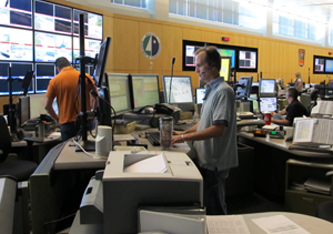
The Regional Transportation Management Center has been open for 10 years in the Roseville location. The RTMC is the hub of traffic management efforts for the Twin Cities area. Photo by Kent Barnard |
Although it was marked with little fanfare, MnDOT’s Regional Transportation Management Center in Roseville—the hub of traffic management efforts in the Twin Cities area—recently marked its 10th anniversary.
The facility, shared by MnDOT and the Department of Public Safety, opened in June 2003, a replacement for the original Traffic Management Center that had operated since 1972 from its perch along Interstate 94 in downtown Minneapolis.
In 2003 the new RTMC brought together three dispatch groups from separate locations in the Twin Cities Metro area: State Patrol, MnDOT Maintenance and Traffic Operations. Consolidation of the three groups greatly increased and improved coordination among the functions. And the ensuing 10 years has seen much growth and expansion among all the partners.
When the new dispatch center opened, there were 385 traffic cameras on the Twin Cities freeway system. Today, the system has 550 cameras on-line to monitor traffic flow and incidents. The number of dynamic messages signs also has almost doubled in the past 10 years from 76 to 150. The signs alert motorists to incidents, delays and closures due to construction or maintenance activity.
And when the new center opened, there were no intelligent lane control signals. Today, the system boasts 325 ILCS on I-35W between Burnsville and downtown Minneapolis and on I-94 between Minneapolis and St. Paul. The electronic signs are mounted over the traffic lanes to provide real-time status of the high occupancy vehicle lanes in addition to providing alerts about lane blockages. The signs also can display advisory speed limits and designate when the priced dynamic shoulder lane is open to traffic.
This past year also has been a time of growth and major changes at the dispatch center.
- State Patrol: Ten statewide dispatch/call centers have been merged into two centers located in the Twin Cities and Rochester. This has presented a challenge hiring and training staff. As with all positions in all three groups there is a very distinct learning curve.
- MnDOT Maintenance Dispatch: This function operates 24 hours a day, seven days a week, and interacts closely with both State Patrol and Traffic Operations. Maintenance dispatchers have the task of trying to keep everyone—from state troopers to project engineers to the public—happy. They constantly adjust from snow and ice to working with the evening maintenance shops and then back to snow and ice all winter long. And then spring, summer and fall bring flooding, potholes, construction and a myriad of other maintenance responsibilities.
- Traffic Operations: Numerous changes in technology have improved incident management and response times for the traveling public. The department’s two MnPASS corridors were opened (I-394 in 2005 and I-35W in 2009). Many new field devices including traffic cameras, ramp meters, dynamic message signs, lane control signals and gate arms have been added since 2003 for an increase of 927 in 2003 to 1,504 in 2012.
- Freeway Incident Response Safety Team: FIRST trucks responded to 26,000 incidents in 2011. Included among those calls were crashes, stalls, jump starts, fuel and tire changes. By rapidly responding to incidents along the freeway system, FIRST drivers were able to lessen the time of those incidents and keep traffic moving with less congestion and delays, while improving safety. And among some of the more interesting and heroic stories, FIRST units have saved lives by pulling a mother and her two children from a quickly sinking car that slid in to a storm water holding pond. They also assisted an hysterical woman who had a live animal inside her vehicle. The driver calmed the woman and then called Animal Control to deal with the raccoon that had crawled in to her engine compartment.
RTMC: Did you know?
- $150 million – Annual benefit of the RTMC operation to motorists traveling in the Twin Cities
- 5,500 – Number of traffic detectors
- 550 – Video cameras
- 450 – Number of ramp meters
- 170 – Large overhead dynamic message signs that display real-time road information for motorists
- 16 to 1 - Payback to taxpayers for investment in FIRST trucks
- 1 to 4 - For every one minute that a lane of traffic is blocked by a crash, it takes four minutes for traffic back-up to dissipate
- Antarctica – The only continent that hasn’t sent visitors to the RTMC.
|
“As we look forward to the next 10 years in traffic management and dispatch technology, there are exciting changes ahead,” according to Brian Kary, freeway operations engineer.
The RTMC is beginning to use additional traffic detection methods with the current loop detectors that are located beneath the pavement surface. A gradual switch to radar detection units known as Wavetronix is underway and the change will reduce installation and maintenance costs. Located on a post alongside the roadway, radar detection units do not have to be imbedded in the pavement and can be repaired year-round if needed.
In the near future, probe data from GPS units may be used to calculate travel times or provide performance data for corridors that do not have instrumentation. This data is already used by companies like Google to provide traffic data on their maps.
In the longer term, cars will begin to provide data to the traffic management system and be able to report travel speeds, road conditions and other valuable information. Known as “Connected Vehicle,” the U.S. Department of Transportation plans to require that vehicles communicate with each other as well as with local transportation departments.
Related information:
|
 |
|

|
 |
TABLE of CONTENTS
 |
Project update: Hwy 75/Hwy 10 project in Moorhead |
By Jerimiah Moerke, District 4 public affairs coordinator
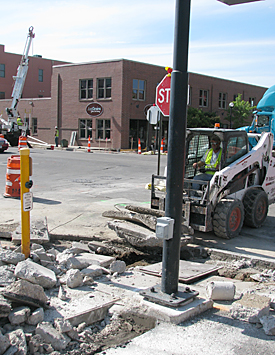
Crews replace pedestrian ramps and signals at Main Avenue and Fourth Street in Moorhead.
Photo by Jerimiah Moerke |
District 4 has reached the halfway point on the Hwy 10/Hwy 75 project in Moorhead. The two highways are the major routes through the core of the city.
This summer’s Moorhead project is a smorgasbord of projects—pedestrian accessibility improvements, traffic safety and capacity upgrades, fiber networks, resurfacing and more. The project is the result of coordination between stakeholders ranging from Concordia College to the Freedom Resource Center, a local disability resource center.
In late May crews began installing a new fiber optic network, upgrading traffic signals and constructing ADA-compliant pedestrian ramps. Once that work is complete, Hwy 10, one of the main roads connecting Fargo, N.D., and Moorhead, will be resurfaced.
Drivers are already seeing new signals, and pedestrian ramp work is about 50 percent complete. The $4.7 million project is on track to be finished by late September.
Pedestrian accessibility and safety improvements
Moorhead’s pedestrian ramp and accessible pedestrian signal replacement project is the largest APS project in Minnesota this summer. Crews are installing new pedestrian ramps at approximately 80 corners. New upgraded crosswalk indicators and push buttons are being installed at about 15 signals along the Hwy 10 and Hwy 75 corridors. The APS systems provide both audible messages and vibro-tactile cues indicating when pedestrians are allowed to safely cross the road.
A new high-intensity activated crosswalk signal will be installed on Hwy 75 near Concordia College. The college is located on both sides of Hwy 75, and jaywalking is a problem in the area. Several options were considered, including an above ground walkway, a full traffic signal and a raised median, but all of the options had issues. The new HAWK signal will provide students and other pedestrians a safe, marked crossing. In addition, Concordia will install a decorative fence along Hwy 75 in the area to prevent jaywalking.
Traffic signals/fiber optics
The signals along the highways are also receiving a major technological upgrade.
Crews are installing fiber optic cable along nearly the entire route of Hwy 10 and Hwy 75. The cable will connect all MnDOT signals and several strategically placed real-time cameras. The fiber and camera network will allow the signals to talk to one another and allow District 4 signal operators to remotely monitor, check and adjust signals without having to travel to Moorhead.
New signals with flashing yellow arrows--the first in District 4--will also help minimize delays adjacent to the BNSF Railway tracks. Each day, 80 to 100 trains run through downtown Moorhead, a number that’s only expected to increase because of the oil boom in North Dakota. While no signal will eliminate delays with that many trains, the new signals and controllers will help. In addition, the new signals and fiber connections open the door to more signal coordination in the future between MnDOT, the North Dakota DOT, and the cities of Moorhead and Fargo.
Resurfacing
Drivers are anxiously waiting for the resurfacing of Main Avenue/Hwy 10 from the Red River to Eighth Street/Hwy 75. Heavy truck loads during the flood of 2009 took a toll on the road. Resurfacing will begin after the other work is complete.
For more information, visit: www.mndot.gov/d4/projects/downtownmoorhead. |
 |
|

|
 |
TABLE of CONTENTS
 |
State awards $45 million in grants to improve roads, economic development in 15 communities |
|
Two state programs will provide $45 million in grants that will help improve the quality of life, economic competitiveness and transportation infrastructure in 15 Minnesota communities.
As part of the Corridor Investment Management Strategy, MnDOT awarded $30 million in grants to 10 highway projects.
"These grants will help preserve our high quality of life and leave a legacy of a more competitive economy and healthier environment for generations to come," said Commissioner Charlie Zelle.
Through CIMS, MnDOT supports building and maintaining a sustainable transportation system through solutions that ensure a high return-on-investment and complement Minnesota’s unique social, natural and economic features.
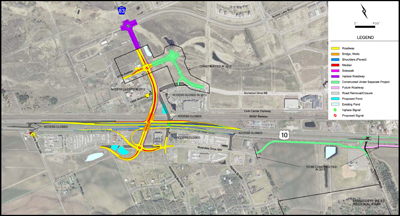
The Hwy 10 and Armstrong Boulevard Interchange was awarded a CIMS grant for $10 million. The project will construct an interchange and grade separated rail crossing over the Burlington Northern Santa Fe line at Hwy 10 and County State Aid Highway 83 (Armstrong Boulevard) in Ramsey. The interchange will improve safety at this busy intersection, ensure a reliable crossing for emergency responders and improve access to the Ramsey Northstar station.
|
MnDOT was aided in the selection process by a state agency advisory group that included the departments of Health, Public Safety, Natural Resources, Commerce, Education, Employment and Economic Development, as well as Explore Minnesota Tourism and the Pollution Control Agency.
The $30 million will help leverage an additional $65 million in other federal, state and local funding for a total construction program of almost $100 million. Funding for the program came from a one-time appropriation from the trunk highway account.
MnDOT received 45 applications requesting more than $100 million in funding. Scoring was based on analysis of social, environmental and economic benefits of each project.
“There are far more worthy projects than there is money to go around,” Zelle said. “To achieve the future transportation vision and to maintain and operate the current system, Minnesotans must spend more today than we have in the past.”
In addition to the CIMS program, MnDOT awarded $15.7 million in grants to five state trunk highway projects under the Transportation Economic Development Program. The funding was awarded in partnership with the Department of Employment and Economic Development and will support growing industry and businesses, and improving the transportation network.
“Transportation investments support jobs, create vibrant communities and position businesses for the global economy,” Zelle said. “MnDOT’s partnership with DEED and the business community through the TED program has seen great results in promoting economic development all across the state.”
MnDOT and DEED have provided nearly $70 million in grants to 29 communities through the TED program since 2011. Program criteria emphasize improvements that enhance the statewide transportation network, including all modes and all jurisdictional systems, and improvements that allow existing businesses to expand or new businesses to locate near the project area. The TED program has leveraged more than $125 million from public and private partners who derive a direct benefit from the improvement.
The $15.7 million provided this year will help leverage an additional $25 million in other federal, state, local, and private funding for a total construction program of $40 million. Funding for the program came from a one-time appropriation from the trunk highway fund.
For more information about these programs and selected projects, visit: www.mndot.gov/cims (CIMS) and www.dot.state.mn.us/funding/ted.html (TED).
|
 |
|

|
 |
TABLE of CONTENTS
 |
MnDOT goes above and beyond in support of military members |
|
By Rich Kemp
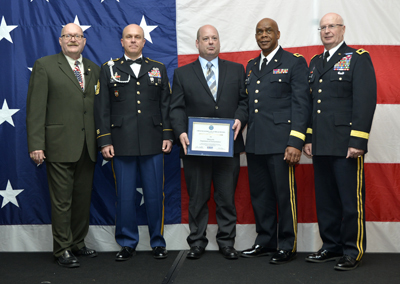
From left, Minnesota ESGR State Chair Paul Monteen; 1st Sgt. Thomas Mitchell, Metro District hydrologist; Brian Kelly, Metro Water project manager; Brig. Gen. Alton Berry, 88th Regional Support Command commander; and Maj. Gen. Richard C. Nash, Minnesota National Guard adjutant general. Mitchell nominated Kelly for the ESGR 'Above and Beyond' award, which was presented at the ESGR awards banquet. Photo by Sgt. 1st Class Blair Heusdens, Minnesota National Guard |
The Department of Defense recognized MnDOT and 32 other employers of Minnesota National Guard and Reserve members at the Minnesota Employer Support of the Guard and Reserve Awards Banquet May 20 in Bloomington.
“I have deployed three times and they have always been supportive,” said Thomas Mitchell, a hydrologist for the Metro District. “They sent care packages and (my supervisor) has been very cooperative when I had medical appointments after I returned.”
Mitchell, a first sergeant in the Army Reserve, was talking about his co-workers and his supervisor, Brian Kelly, whom Mitchell nominated for an ESGR “Above and Beyond” award for the support Kelly has provided during Mitchell’s military duty.
“1st Sgt. Mitchell’s nomination indicated that MnDOT and Mr. Kelly provided exceptional support to their military employees,” said Paul Monteen, ESGR state chairman.
Andy Kubista, snowplow simulator manager, returned to work in May after a deployment to Afghanistan with the 257th Military Police Company of the Minnesota National Guard.
“The support was great while I was deployed,” said Kubista. “They kept me up to date on what was going on back here and called my wife to see how things were going. They have always been supportive when I had to go to training.”
Chase Fester, bridge maintenance supervisor in Windom, has deployed to Iraq twice with the 114th Fighter Wing of the Air National Guard. He also deployed to help with flood support.
“I haven’t had any issues,” said Fester. “My supervisor said ‘Go serve our country, we will take care of things back here.’ They also said ‘Take the time you need with your family’ when I returned from the deployments.”
Mitchell, Kubista and Fester are just a few of the employees who serve their country while working for MnDOT. The Office of Human Resources created a section on iHUB for military members and their familiesThe site includes resources such as Beyond the Yellow Ribbon, Military OneSource and a video to assist military families, “We all serve Fort Minnesota.”
“We are proud of their service to our country, and we are proud of their contributions here at MnDOT,” said Eric Davis, Enterprise Risk Management director. “We want them to know they have our support while they are serving our country.”
Related information:
|
 |
|

|
 |
TABLE of CONTENTS
 |
Help shape tomorrow’s highways |
|
The Office of Traffic, Safety and Technology is looking for your help in updating Minnesota’s Strategic Highway Safety Plan. The SHSP prioritizes focus areas and identifies strategies for reducing crashes and moving Minnesota toward zero deaths.
So far this year, 160 people have died in crashes compared to 146 people at this point in 2012. MnDOT continues to work with its safety partners across the engineering, enforcement, education and emergency medical disciplines to prevent this number from growing.
The new SHSP is being updated this year using crash data and input from Minnesota’s safety community. Visit www.SHSP.ideascale.com to share your ideas for safety strategies that will reduce crashes. You can browse ideas already submitted and comment or vote on them, or you can submit new ideas of your own. Your ideas are needed by July 31. If you have questions about the SHSP update, contact Brad Estochen, Office of Traffic, Safety and Technology. |
 |
|

|
 |
TABLE of CONTENTS
 |
On the Job: Claudia Dumont is bringing diamonds to Minnesota |
District 3 project manager and engineering specialist Claudia Dumont talks about diverging diamonds, career opportunities at MnDOT and the increasing role of women at the agency. Video produced by Bob Filipczak |
|
 |
|

|
 |
TABLE of CONTENTS
 |
Voices: Seeds graduates talk about success at MnDOT |
By Lisa Yang
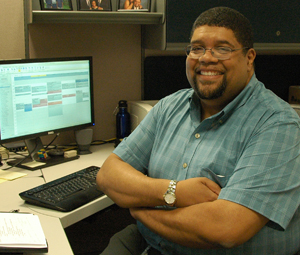
Stephen McGregor, MN.IT@DOT Systems Analysis Unit supervisor in MnDOT's Central Office, credits the Seeds program with his success in information technology at MnDOT. Photo by Lisa Yang
|
MnDOT launched the Seeds Program in 1993 to help the workforce better reflect the communities the agency serves. Since then, MnDOT has placed 75 percent of the Seeds students in permanent, full-time positions, according to Calahena Merrick, Seeds Program manager. Some of them are still with the agency today.
They include Stephen McGregor, MN.IT@DOT Systems Analysis Unit supervisor in MnDOT's Central Office; Adam Johnson, heavy equipment mechanic in District 1/Duluth; Gina Alvarado, Account clerk in District 4/Detroit Lakes; and Benard Obwocha, land surveyor in Central Office’s Geodetic Unit.
“The Seeds program and the students make an important contribution to MnDOT’s workforce by not only adding diversity, but it adds different perspectives, creates a culture of inclusion, and helps MnDOT build a reputation as an employer of choice,” said Merrick.
As part of Seeds 20th anniversary, we’ve asked these employees to talk about how they started and where they are now.
Stephen McGregor: IT Supervisor
“I was one of the first few Seeds workers hired 20 years ago. I started my information technology career at MnDOT in D1 while I was studying computer science at the University of Minnesota in Duluth.
They were going through some IT-related upgrades in D1 so I got to help with the upgrades including taking out wires and putting in new infrastructure. The experience helped introduce me to MnDOT’s environment and put me in a position where I could work with technology leaders inside and outside of MnDOT.
After a year, I was promoted to a Rule 10 and became an UNIX administrator and traveled to all MnDOT locations using the state plane in order to support the system statewide. Then, I was assigned a permanent IT position in the Central Office, and I’m now supervising the team that maintains MnDOT’s Central Office network services.
I’ve also hired and mentored Seeds students and some of them are still working at MnDOT in permanent positions.
I support the Seeds program because I think the goal of the program is really good.”
Adam Johnson: Mechanic
“I was hired in June 1997. I started working in the Duluth Repair Shop, which is where I work now. I was a student in the Diesel and Truck Mechanics Program at Lake Superior College when a MnDOT shop supervisor came to the school to recruit and fill temporary student worker positions in the shop.
So, I worked a couple of hours a day after school and also worked until late-evening some days to help out during snow and ice events.
I thought the student worker position was only temporary, but it was extended twice. After I graduated, a full-time mechanic position opened up in the same shop. I applied and got the job in September 1998.
I currently maintain and repair everything from lawn mowers to heavy equipment. My main focus is on snow and ice removal equipment.
Being in Seeds gave me a chance to get experience in my field while still in school. I learned more my first summer at MnDOT then I did in my two years of schooling.”
Gina Alvarado: Accounting
“I was hired in December 1997, and I’ve worked in District 4/Detroit Lakes my entire 15 years with MnDOT. I heard about Seeds through a college counselor. After completing my degree in Accounting, I was hired as a permanent, full-time employee to do the same accounting work.
I currently work with Accounts Payable and handle all of the district’s utilities invoices. I also do the weekly cycle count for our inventory department.
If it weren’t for this program, I highly doubt I would be working at MnDOT.”
Benard Obwocha: Land surveyor
“I was hired in 2004 and was in training to be a land surveyor. I graduated from St. Cloud State University a year later and was hired into the Graduate Engineer and Land Surveyor Program as the first Graduate Land Surveyor. Then, I was hired into a permanent, full-time land surveyor position in 2008.
I’m currently the geodetic database support leader. I also work with student workers to ensure that the database information is accurate and up-to-date.
Seeds provided me with excellent opportunities for career and educational development. The flexible schedule made it possible to achieve my academic goals and work at the same time.
It was a great experience for me. Seeds contributed to my growth both socially and professionally. I would recommend the program to any student who is aspiring to gain knowledge and experience from a great agency and its professionals.” |
 |
|

|
 |
TABLE of CONTENTS
 |
Pride Parade is positive experience |
By Sue Mulvihill, Employee and Corporate Services Division director
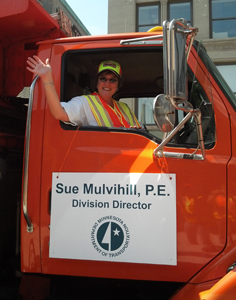
Sue Mulvihill, Employee and Corporate Services Division director, rode in a MnDOT truck during the Pride Parade June 30 in Minneapolis. Photo by Rob Williams |
The Pride Parade was an opportunity for MnDOT to support its GLBTQ community and to send a message to others that we are a ‘Workplace of Choice.’ At 10 a.m. on the morning of June 30, 30 or so MnDOT employees met to participate in the Twin Cities Pride Parade. This group included employees from our Camden Truck Station, and a MnDOT plow truck, complete with plow and wing. The message on the side of the truck read: “Clearing the Way for Diversity.” This is a strong, consistent message carried by the MnDOT Diversity Council, our department leadership, and most specifically for this event, the Q & A Employee Resource Group. It is because of the ERG that MnDOT got involved in the parade and the festival.
I didn’t know what to expect on this day. It certainly was gratifying to have the thousands of people lining Hennepin Avenue cheering and thanking MnDOT for all the hard work we do and for the message encouraging and supporting diversity in our workforce. There were no jeers, no negative comments. It was an event that reinforced how proud I am to work at MnDOT and to be the ‘Champion’ for the Q & A ERG, and how much the people of Minnesota truly appreciate our department. We also had many people stopping by the MnDOT festival booth to gather information on state employment and to get a highway map.
So when someone asks me why MnDOT participates in parades and specifically the Twin Cities Pride Parade, I can say from personal experience that the positive response we get from these events is worth many paid advertising spots. It provides communication and a connection to our customers and is definitely uplifting for the employees who participate.
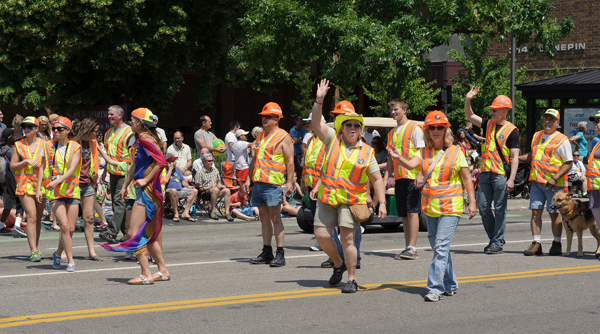
More than 30 MnDOT employees marched in the Pride Parade June 30 in Minneapolis as part of the Q & A Employee Resource Group contingent. Photo by David Gonzalez |
|
 |
|
| |
|



